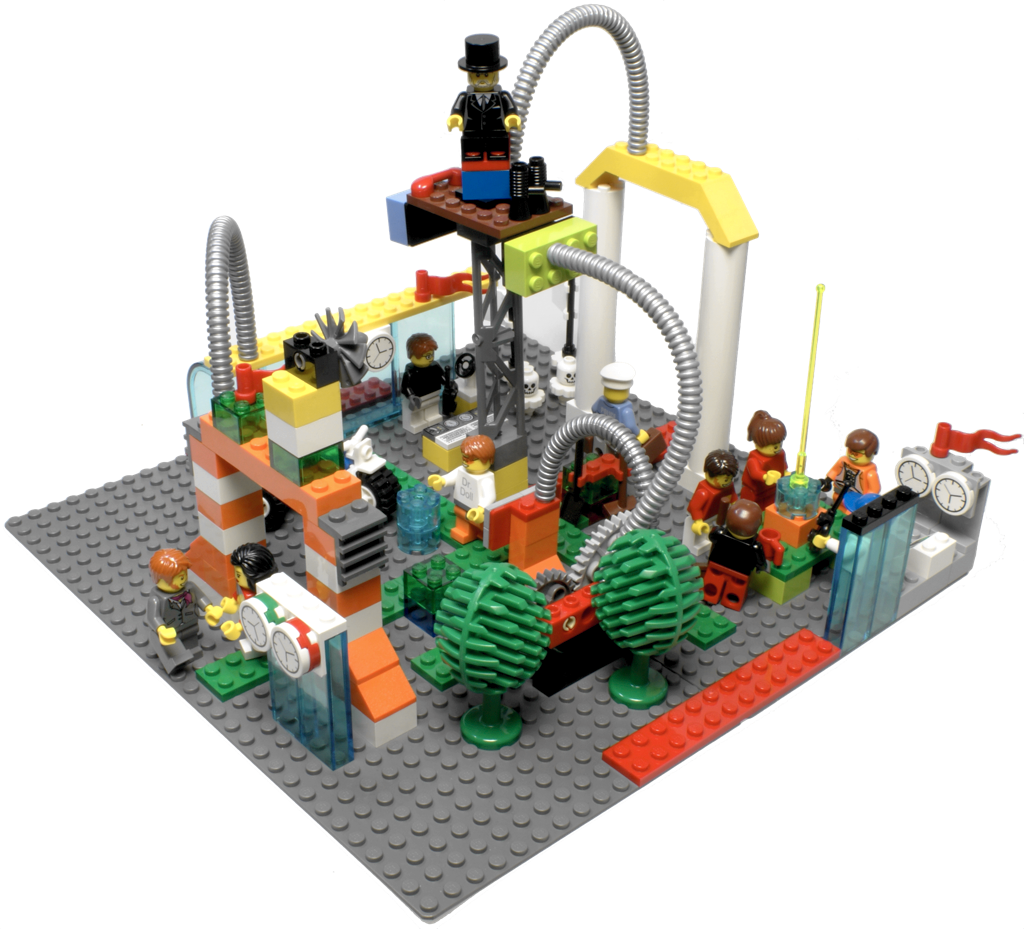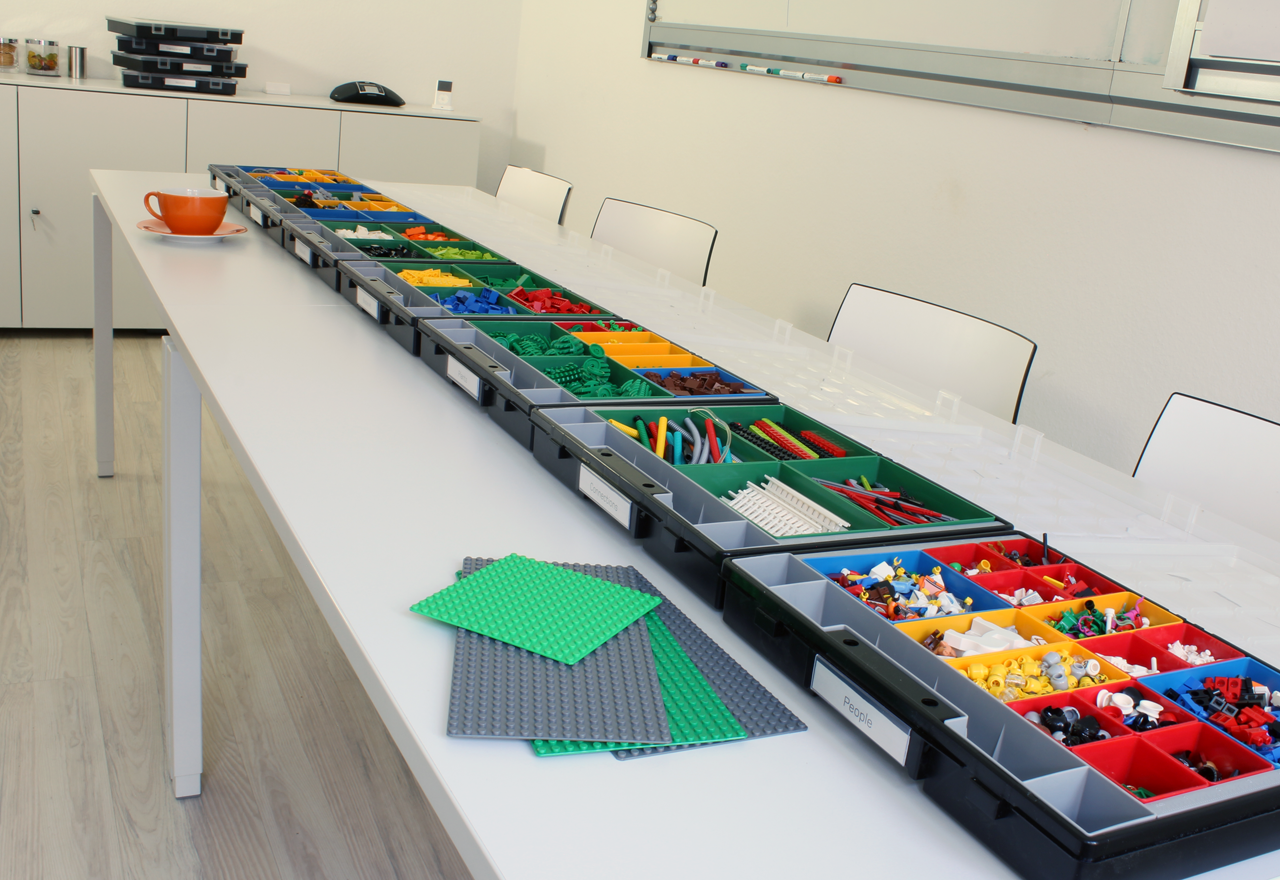LEGO Serious Play
Modeling with LEGO bricks is a very powerful approach to develop aligned answers for tough and abstract questions in a highly diverse group of people. Think of questions such as...
"What value do we create for customers and how?"
"What should a 10-star customer experience look like?"
"What is good leadership for our company?"
"What kind of innovation culture do we want to establish here?"
"What should our company look like in 5 years from now?"
If you would raise one of these questions in a regular meeting, you might end up in pointless discussions with no clear results or decisions. Words are somewhat limited in conveying abstract ideas and thoughts. And here is where LEGO bricks can play an important role. Why LEGO bricks?
LEGO is very easy to use, relatively cheap, doesn't make any dirt and works perfectly in an office environment.
LEGO offers a huge range of different bricks from windows, mini figures, accessories, trees, flowers, animals, etc. that allows us to build highly specific models.
LEGO bricks also allow us to think in metaphorical expressions. While building a model, the modeler can re-interpret the meaning of a brick to communicate abstract aspects (e.g. a tree can stand for life-long learning).
A model built with LEGO bricks can be easily modified right on the spot. That means that a LEGO model is literally able to follow a team discussion, if the team keeps modifying the model based on what they are talking about. Not many "tools" are able to do so, aren't they?
Building LEGO models is great fun for many people. It motivates human beings to build something with their own hands and see things "growing". Very often people get into a flow experience while putting bricks LEGO together. It is a great exercise for team development.
How Does it Work?
Well, LEGO bricks can be used in many different ways depending on the purpose of the exercise. If your task is to align different perspectives in a team, the following procedure might be helpful:
Always start with some warm-up exercise to let participants of a workshop understand why and how we build models with LEGO bricks. It is like learning a new language (= 3D modeling).
Raise your questions (see examples above) ask everybody to answer that question by building an individual model.
Let every participant explain their individual models by telling a story to the whole team. Allow questions to support understanding and reject critique.
Ask the participants to mark the most important features / aspects of the individual models with red / blue / green flag.
Invite the participants to create a shared model by considering ALL the marked features / aspects of the individual models and let the team present the full story (together).
Derive guiding principles out of the shared model that helps answer the question raised before and boil them down to concrete actions / tasks / initiatives etc.
Repeat the steps 1.- 6. for other questions (if necessary).
You can also "just" build a service encounter, for instance, without merging different perspectives as illustrated before. Feel free to use the bricks as you like! It's fun and serious!
LEGO models are usually NOT the right artifacts to present them to customers for feedback. It is more an internal tool for Business Design project teams. However, you can easily transfer a LEGO model into a properly designed 3D rendering with tools such as Cinema 4D or freeware tools.
Usage Scenarios
Envisioning a service encounter / process / experience
Building a vision for a company
Visualizing a corporate culture or leadership style
Developing great teams
In short: Aligning different perspectives on abstract topics
Warm-up Exercises
Solving Problems in 3D
Show the picture below and ask participants of your workshop to draw the third perspective.
Allow 2-3 minutes to finish the drawings and then hand out three LEGO standard bricks with 8 dots on top to each participant (preferably in different colors).
Ask them to solve the same problem with the bricks (instead of drawing) and observe them carefully.
Discuss after 1-2 minutes the difference between the two approaches of solving 3D problems in 2D (pen & paper) and 3D (= LEGO).

Metaphorical Building
Ask the participants to pick 10 random bricks and put them together (without any further rules).
Build sub-teams of two people and let them present their models to each other by answering the following question: Why does this model represent a perfect boss / best friend / colleague / entrepreneur etc. (pick one)?
Reflect afterwards how our brain is capable of creating meaning for everything that is sensed with our eyes, ears, hands etc. We should use this power in 3D modeling and start building even if don't know what to build. We just start...our brain will do the rest).
Building a Tower
Ask the participants to pick 10 bricks that allows them to build a tower that is as tall as possible. A mini figure has to be placed on top of each tower.
Observe the participants carefully how they react to the challenge, embrace competition and develop an emotional binding to what they build.
Discuss your observations and focus specifically on the aspect that modeling helps us create passion and an emotional relationship to what we do despite huge uncertainties usually involved in Business Design projects.
Example
The following example shows how a multimedia agency creates value for clients. Many metaphorical expressions help to understand aspects that are hard to communicate with words.

Tools & Materials
In Business Design projects, we use a specially assembled LEGO Kit that supports the process of building "social systems". Thus, the kit consists of bricks covering the following categories:
Actors / people
Connections / relationships
Metaphorical expressions (motion, growth, boundaries etc.)
Standard bricks
The picture shows how the LEGO bricks can be presented in a workshop:

ps: You can order a good selection of bricks at the LEGO store:
The picture below shows a group of students at a Nigerian entrepreneurship centre (CYID) discussing a new concept to help farmers sell directly to end-consumers. Engaged discussions like this is what LEGO is able to trigger...awesome!

Instructions for Coaches
Encourage participants of your workshop to start building something even if they don't know what. Again, our brain is powerful enough to instantly create a meaning of the model, which is eventually a great starting point.
Always build LEGO models on large plates. Otherwise, it will be almost impossible to carry them around or connect them with other models.
Let the participants tell different stories around their models, e.g.
Inside out: "Hey, this is me, employee of this department. In the future, I will play this role and do this and that..."
Outside in: "This is our future customer! He / she will go through this gate, which already shows the key ingredients of our work culture..."
From past to future: "Well, in the past we did this...., from tomorrow, we will be doing that..."
Take pictures of the models after a workshop and document every element and the story around. Powerpoint is a great tool for that. Another good idea is to record a video of someone explaining the model and pointing at the corresponding element of the model.
Good Readings
Kristiansen, P. & Rasmussen R.: Building a better business using LEGO Serious Play method (Amazon)
Roos, J., Victor B. & Statler, M.: Playing seriously with strategy (Science Direct)
